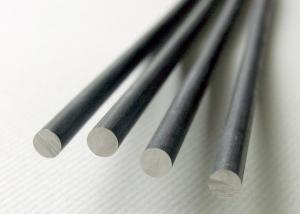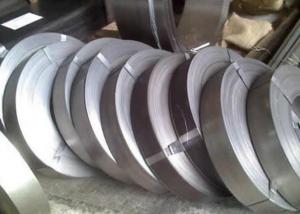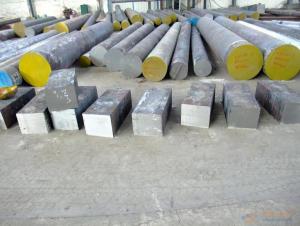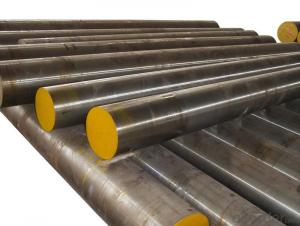Round Steel Spring Bar 60Si2MnA
- Loading Port:
- China Main Port
- Payment Terms:
- TT or LC
- Min Order Qty:
- 50MT m.t.
- Supply Capability:
- 600000TONS/YEAR m.t./month
OKorder Service Pledge
OKorder Financial Service
You Might Also Like
Spring Steel can be divided into two types. One is carbon spring steel, and other one is alloy spring steel.
Alloy spring steel is based on carbon spring steel, by adding one or more alloying elements to improve the mechanical properties, hardenability and other properties to meet the requirement for manufacturing all kinds of spring steel.
Specification of Round Steel Spring Bar:
-Material: 60Si2MnA
-Standard: GB
-Type: Spring Steel
Corresponding Steel Grade for Reference:
CHN, GB | JPN, JIS | GER, DIN | GBR, BS |
60Si2MnA | SUP6/SUP7 | 60SiCr7 | 251H60 |
FRA, NF | USA, AISI/SAE | ISO | |
61SC7 | H2600 | 61SiCr7 |
Chemical Composition:
C | Si | Mn | S |
0.52~0.6 | 1.50~2.00 | 1.00~1.30 | ≤0.035 |
P | Cr | Ni | Cu |
≤0.035 | ≤0.35 | ≤0.35 | ≤0.25 |
V | B | ||
0.08~0.16 | 0.0005~0.0035 |
Mechanical Properties:
-Tensile Strength σb (MPa): ≥1372 (140)
-Yield Strength σs (MPa): ≥1225 (125)
-Elongation δ10(%): ≥5
-Percentage reduction of area: ψ (%): ≥30
-Hardness:
1, Hot rolled, ≤321HB
2, Cold drawn + Heat treatment: ≤321HB
Usage/Applications of Round Steel Spring Bar:
-60Si2MnA contains little alloying elements. Its hardenability is higher than 60Si2Mn. The decarburizing tendency is small and the prime cost is low.
-Products of this material are used as flat spring o spiral spring with diameter less than 30mm that bear a large load during the fabrication of trains, cars and tractors.
Packaging & Delivery of Round Steel Spring Bar:
-Packing Detail: The products can be packed in bundles by steel wires.
-Delivery Detail:
1, Delivery time: 30~45 working days after receive buyer’s T.T. or L/C.
2, Delivery status should be written in the contract. (Heat treatment or no)
Payment:
-Invoicing on theoretical weight or actual weight as customer’s request.
-FOB, CFR or CIF.
-Regular terms of payment:
1, 30% payment in advance, the remaining balance (70% payment) against the copy of B/L. 100% payment before shipment.
2, 30% payment in advance, the remaining balance (70% L/C) against the copy of B/L. 100% payment before shipment.
3, Negotiable.
Photos of Round Steel Spring Bar:
-Round Steel Spring Bar 1:
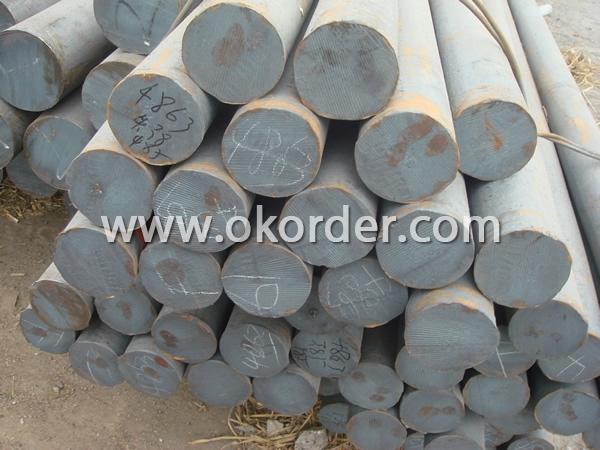
-Round Steel Spring Bar 2:
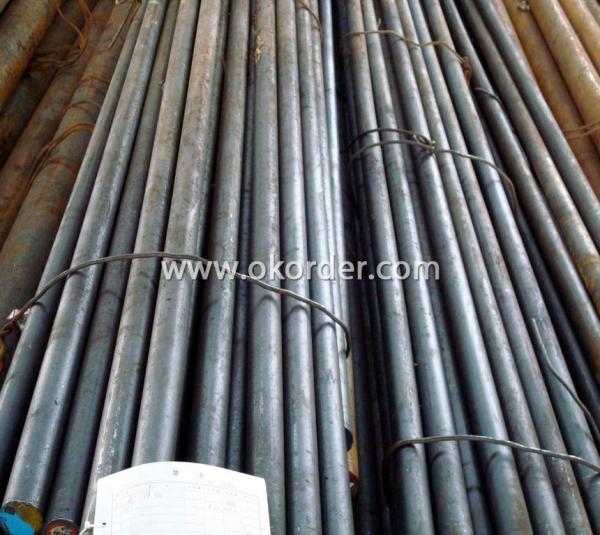
-Round Steel Spring Bar in the factory:
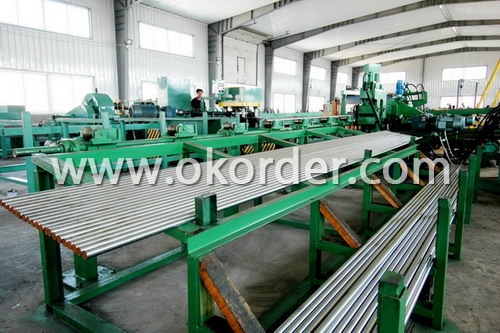
- Q:What are the different galvanizing techniques used for special steel?
- There are several galvanizing techniques used for special steel, including hot-dip galvanizing, electro-galvanizing, and mechanical galvanizing. Hot-dip galvanizing involves immersing the steel in a bath of molten zinc, creating a thick, durable coating. Electro-galvanizing, on the other hand, uses an electrical current to deposit a thin layer of zinc onto the steel surface. Mechanical galvanizing involves tumbling the steel in a zinc powder and glass bead mixture, which adheres to the surface through friction. Each technique has its own advantages and is used depending on the specific requirements of the application.
- Q:What are the different methods for improving the toughness of tool steels used in special steel?
- There are several methods for improving the toughness of tool steels used in special steel. One common method is through the addition of certain alloying elements, such as vanadium or tungsten, which can enhance the steel's toughness while maintaining its hardness. Another method is through heat treatment processes, such as tempering or quenching, which can help to refine the steel's microstructure and improve its toughness. Additionally, the use of specific manufacturing techniques, such as hot working or forging, can also contribute to enhancing the toughness of tool steels.
- Q:Can special steel be machined easily?
- No, special steel is typically harder and more difficult to machine compared to regular steel due to its higher alloy content and specific properties.
- Q:What are the main advantages of using special steel in the construction of bridges?
- The main advantages of using special steel in the construction of bridges are its high strength, durability, and resistance to corrosion. Special steel, such as high-strength low-alloy steel or weathering steel, can withstand heavy loads and extreme weather conditions, making it ideal for bridge construction. Its superior strength allows for the design of lighter and more cost-effective structures. Additionally, special steel's resistance to corrosion reduces maintenance and repair costs, ensuring the longevity and safety of the bridge.
- Q:What are the different surface finishing techniques used for special steel?
- Some of the different surface finishing techniques used for special steel include electroplating, powder coating, galvanizing, passivation, and mirror polishing.
- Q:How does special steel resist oxidation?
- Special steel is known for its excellent resistance to oxidation. This is primarily due to the presence of elements such as chromium, nickel, and manganese in its composition. These elements form a protective layer on the surface of the steel, known as a passive film, which acts as a barrier against oxygen and moisture. Chromium is the key element responsible for the oxidation resistance of special steel. It reacts with oxygen in the atmosphere to form a thin layer of chromium oxide on the surface of the steel. This oxide layer is highly stable and prevents further oxidation of the underlying metal. It acts as a shield, preventing the diffusion of oxygen and moisture into the steel, which could lead to corrosion or rusting. Additionally, nickel and manganese also contribute to the oxidation resistance of special steel. They help stabilize the passive film formed by chromium oxide and enhance its protective properties. These elements also increase the steel's ability to withstand high temperatures and corrosive environments. Moreover, the composition and processing techniques used in the production of special steel play a crucial role in its oxidation resistance. The steel is often subjected to heat treatment processes, such as annealing or quenching, which further enhance its corrosion resistance properties. The careful control of alloying elements and precise heat treatment procedures ensure the formation of a robust and durable passive film. In conclusion, special steel resists oxidation primarily due to the presence of chromium, nickel, and manganese, which form a protective layer on its surface. This passive film acts as a barrier against oxygen and moisture, preventing corrosion and rusting. The composition and processing techniques employed during production also contribute to the exceptional oxidation resistance of special steel.
- Q:What are the different methods of surface shot blasting for special steel?
- There are several different methods of surface shot blasting that can be used for special steel. Some of the most common methods include: 1. Wheel blasting: This method involves using a wheel with abrasive particles to blast the surface of the special steel. The wheel spins rapidly and throws the abrasive particles onto the steel, removing any contaminants or imperfections. 2. Air blasting: In this method, compressed air is used to propel abrasive particles onto the surface of the special steel. The high-speed impact of the particles helps to clean and prepare the surface for further treatment or coating. 3. Wet blasting: This technique involves mixing abrasive particles with water and then spraying the mixture onto the surface of the special steel. The water helps to control the dust and heat generated during the blasting process, making it suitable for sensitive or delicate steel surfaces. 4. Vacuum blasting: Vacuum blasting combines the use of abrasive particles with a vacuum system to remove both the particles and the contaminants from the surface of the special steel. This method is particularly useful for removing paint or coatings from the steel. 5. Shot peening: Shot peening is a specialized form of shot blasting that is used to enhance the strength and fatigue resistance of the special steel. It involves bombarding the surface with small spherical particles, which create compressive stresses that improve the steel's durability. Each of these methods has its own advantages and is suitable for different types of special steel and surface conditions. The choice of method will depend on factors such as the desired surface finish, the level of contamination, and the specific requirements of the steel application.
- Q:How does electrical steel contribute to the production of transformers and motors?
- Electrical steel, also known as silicon steel or lamination steel, plays a crucial role in the production of transformers and motors. Its unique magnetic properties make it an ideal material for the cores of these devices. The high silicon content in electrical steel reduces the energy losses that occur due to magnetic hysteresis and eddy currents, making the transformers and motors more efficient. Additionally, the laminated structure of electrical steel helps to minimize the eddy current losses further. Overall, the use of electrical steel in transformers and motors improves their performance, increases energy efficiency, and allows for compact and lightweight designs.
- Q:How does special steel perform in terms of fatigue strength?
- Special steel generally performs well in terms of fatigue strength. It is specifically designed to withstand repeated loading and unloading without experiencing fatigue failure. Its unique composition and heat treatment processes make it highly resistant to crack initiation and propagation, resulting in an extended fatigue life compared to regular steel. Additionally, special steels often exhibit improved resistance to other forms of degradation, such as corrosion, which further enhances their overall fatigue performance.
- Q:How is leaded steel used in machining operations?
- Leaded steel is commonly used in machining operations due to its improved machinability. The addition of lead to the steel composition enhances its ability to be cut, drilled, and shaped with ease, reducing tool wear and improving surface finish. This type of steel is particularly useful in high-speed machining applications, where efficiency and precision are crucial.
1. Manufacturer Overview |
|
|---|---|
| Location | Jiangsu, China |
| Year Established | 2003 |
| Annual Output Value | Above US$ 30 Million |
| Main Markets | Asia-Pacific; Middle east |
| Company Certifications | |
2. Manufacturer Certificates |
|
|---|---|
| a) Certification Name | |
| Range | |
| Reference | |
| Validity Period | |
3. Manufacturer Capability |
|
|---|---|
| a)Trade Capacity | |
| Nearest Port | Shanghai. |
| Export Percentage | 20% - 30% |
| No.of Employees in Trade Department | 10-20 People |
| Language Spoken: | English; Chinese |
| b)Factory Information | |
| Factory Size: | Above 100,000 square meters |
| No. of Production Lines | 2 |
| Contract Manufacturing | OEM Service Offered; |
| Product Price Range | Average |
Send your message to us
Round Steel Spring Bar 60Si2MnA
- Loading Port:
- China Main Port
- Payment Terms:
- TT or LC
- Min Order Qty:
- 50MT m.t.
- Supply Capability:
- 600000TONS/YEAR m.t./month
OKorder Service Pledge
OKorder Financial Service
Similar products
New products
Hot products
Hot Searches
Related keywords
















